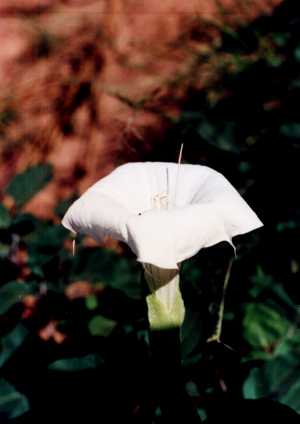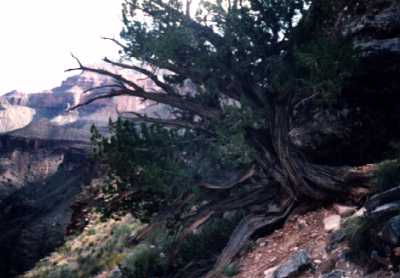



Likewise, every plant you touch--much less pluck--and animal you feed or bother is an alteration in the course of natural history. A classic science-fiction tale follows the protagonist's travels into the distant past, where he is careful never to disturb, but only to observe. Upon his return to the future, there are subtle differences in life around him--in language, bits of hardware, and so forth--for, despite his care, a single, prehistoric butterfly had been crushed by his boot, snapped out of existence, and carried away from its present into his future, changing the world. This haunting tale gave rise to the environmentalist's image that the evanescent breath of a butterfly's wings may create a storm half a planet away.
 The Sacred Datura
The Sacred DaturaThis is held as truth by the community of hikers, for to treat each step as the creation of an indelible, inevitable change in the future is to give real weight to what seems so light. Out of this truth come simple disciplines, such as this: Don't cut across switchbacks or make a shorter route to a trail you might see ahead. One trail is enough, for, in the short term it can confuse future hikers (the three separate trails we found on the way to Crystal Rapids might have had less experienced hikers lost without water). But far more important is that the human impact on the desert, especially the Grand Canyon, has been severe, and one more trail--like the eternal moonprints--is untenable damage to a fragile ecosystem.
Read about the living soils, the cryptogamic earth, a dark soil (often compared to the texture of brown sugar) that covers virgin desert. Composed of moss, lichens, algae and fungi, cryptogamic soil is a living protective shell for the desert, shielding against erosion, providing nutrients, and retaining moisture. The root filaments of the microscopic plants thread together in a cooperative armor, but an unconsidered off-trail footprint upon this life is a Dresden firestorm in microcosm. A shallow crack can take half a century to heal--if it gets the chance, as wind and water begin to tear at its edges. A hiker twists to call back over his shoulder, sliding a careless foot off the trail ... and this one footprint can be the first step toward a crumbling, eroded chasm, a tiny horror of desert death.
Consider further that your paltry steps today are eddies in the continuing tide of ecological sea-change that began with the first human alterations--native American dwellings cut into the rock, with the detritus of daily life left behind--and washing through to the present, as sweeping environmental alterations are wrought by the Glen Canyon dam; the air is clouded ever more by the coal-burning Navajo Power Station many miles away; and the pollution of the Colorado River and area groundwater is nearly permanent. Even now, another form of pollution continues to worsen: Noise. Sightseeing planes and helicopters roar endlessly over the Canyon, echoing off the redwall in aural, mechanical plunder.
The 20th century only continues ongoing degradation. Most of us middle-aged folks recall Cleveland Amory's Fund for Animals and a curious airlift of burros from the Grand Canyon twenty years ago. The feral remnants of 19th-century mining activities, the hardy burros had multiplied in the desert, destroying vegetation and forcing back the ranges of native species. So the "quaint" miners had left their own ecological mark in the all-preserving desert, including the feral burros, heaps of trash, mines dug into the earth, and fallen-down buildings and corrals. Today these are historic curiosities at sites like Boucher Creek and Horseshoe Mesa, but the slow rate of nature's reclamation reveals them in a different context: as ecological scars.
The Glen Canyon Dam is a special case, and one that grows thornily close to a Grand Canyon hiker's ideological heart. The dam was completed in the 1960's as part of a large system of flood-control and power production structures. This seems an innocent-enough undertaking, until the implications are considered. Native sites and the ecosystem behind the dam were destroyed by drowning from Lake Powell, the artificial body of water that engulfs millions of acres of Utah. The quieted water is stripped of silt and sand, which settles to the bottom of Lake Powell; thus, the sands and periodic floods that kept the Grand Canyon ecosystem in balance have ended. The cold, clear water flowing from the bottom of the lake through the dam has forced native fish to the edge of extinction, and the periodic water releases needed for supplementary power cause unexpected, severe and continuous erosion--without the compensation of beach-building silt and sand.
The expansive ecological impacts of dams and power stations, however, should not diminish our individual, small-scale hiking care. Another discipline, then: Leave behind no trash, including used toilet paper, tampons, bandage backings, pop tops, cigarette butts, gum wrappers, clothing threads or food scraps. While waiting for David and Susan's arrival, Stevie and I spent several hours clearing the beaches at Hermit Rapids, where we were astounded at the amount of trash bits and other careless detritus. In this "wilderness", we collected several handfuls of hiker leavings--not including the river runners' spoor, which was too much for us to carry.
 Humanity was young at this tree's birth
Humanity was young at this tree's birthThat people can damage the desert is the reason the BRO now issues permits. During the notorious Easter vacation of 1972, hundreds of campers descended on The Corridor, overloading the fragile services and natural conditions. The strain and wreckage were severe, and regulation arose quickly thereafter. Other rules, then: No pet animals and their alien defecation and innocent destructions. No fires, for the dry climate invites sweeping conflagrations like that whose scars can still be seen in Hermit Creek. The full legalistic prohibitions can be found on the back of the BRO permit, including: no bows and arrows, firearms, motorized vehicles or crowds; don't throw or roll rocks; fishing permit required; and various strict legalistic details.
Earlier I spoke of altering the course of natural history, and some may argue that humans are also part of the Canyon's natural history. True though that is, in such a desert we come upon an area to which we are not naturally adapted and thus do not biologically belong, unless you believe that humans' natural adaptiveness comes from ingenuity and use of tools--in which case I can suggest only that such selfsame ingenuity and intelligence should encourage us to accept the human role of--at best--humble caretaker, not master of the dominion.
The Middle-Aged Hiker is Copyright ©1993-97,2002 by Dennis Báthory-Kitsz and David Gunn. All rights reserved.
![]() Please offer your comments.
Please offer your comments.
![]() Web pages by Malted/Media.
Web pages by Malted/Media.